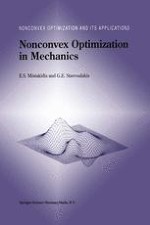Nonconvexity and nonsmoothness arise in a large class of engineering applica tions. In many cases of practical importance the possibilities offered by opti mization with its algorithms and heuristics can substantially improve the per formance and the range of applicability of classical computational mechanics algorithms. For a class of problems this approach is the only one that really works. The present book presents in a comprehensive way the application of opti mization algorithms and heuristics in smooth and nonsmooth mechanics. The necessity of this approach is presented to the reader through simple, represen tative examples. As things become more complex, the necessary material from convex and nonconvex optimization and from mechanics are introduced in a self-contained way. Unilateral contact and friction problems, adhesive contact and delamination problems, nonconvex elastoplasticity, fractal friction laws, frames with semi rigid connections, are among the applications which are treated in details here. Working algorithms are given for each application and are demonstrated by means of representative examples. The interested reader will find helpful references to up-to-date scientific and technical literature so that to be able to work on research or engineering topics which are not directly covered here.
